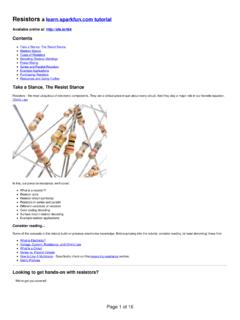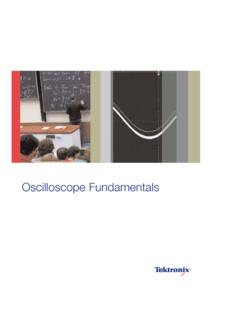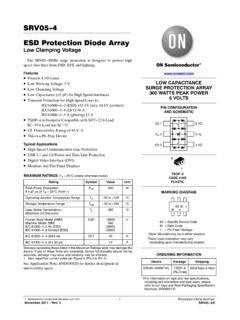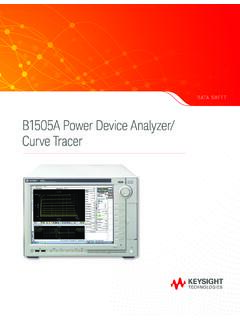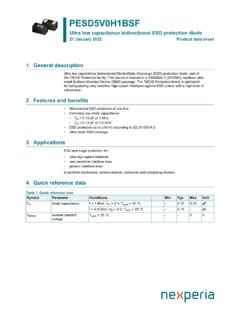Transcription of How to Use an Oscilloscope - learn.sparkfun
1 How to Use an Oscilloscope a online at: of O-ScopesOscilloscope LexiconAnatomy of An O-ScopeUsing an OscilloscopePurchasing an OscilloscopeResources and Going FurtherIntroductionHave you ever found yourself troubleshooting a circuit, needing more information than a simplemultimeter can provide? If you need to uncover information like frequency, noise, amplitude, or any othercharacteristic that might change over time, you need an Oscilloscope !O-scopes are an important tool in any electrical engineer's lab. They allow you to see electric signals asthey vary over time, which can be critical in diagnosing why your 555 timer circuit isn't blinking correctly,or why your noise maker isn't reaching maximum annoyance 1 of 26 Digilent Analog Discovery 2 TOL-1392914 Favorited Favorite 49 Wish ListDSO Nano V3 - Pocket-Sized digital OscilloscopeTOL-11702$ Favorite 48 Wish ListDigital storage Oscilloscope - 100 MHz (TBS2104)
2 TOL-14925 Favorited Favorite 3 Wish ListPage 2 of 26 HAMlab - 160-6 10 WWRL-15001$1, Favorite 9 Wish ListCovered in This TutorialThis tutorial aims to introduce the concepts, terminology, and control systems of oscilloscopes . It'sbroken down into the following sections:Basics of O-Scopes -- An introduction to what, exactly, oscilloscopes are, what they measure, andwhy we use Lexicon -- A glossary covering some of the more common of an O-Scope -- An overview of the most critical systems on an Oscilloscope -- thescreen, horizontal and vertical controls, triggers, and an Oscilloscope -- Tips and tricks for someone using an Oscilloscope for the first 'll be using the Gratten GA1102 CAL -- a handy, mid-level, digital Oscilloscope -- as the basis for ourscope discussion.
3 Other o-scopes may look different, but they should all share a similar set of controland interface ReadingBefore continuing with this tutorial, you should be familiar with the concepts below. Check out the tutorialif you want to learn more!Voltage, Current, Resistance and Ohm's LawHow to Use a MultimeterAnalog vs. DigitalAlternating Current (AC) vs. Direct Current (DC)VideoPage 3 of 26 Basics of O-ScopesThe main purpose of an Oscilloscope is to graph an electrical signal as it varies over time. Mostscopes produce a two-dimensional graph with time on the x-axis and voltage on the example of an Oscilloscope display.
4 A signal (the yellow sine wave in this case) is graphed on ahorizontal time axis and a vertical voltage surrounding the scope's screen allow you to adjust the scale of the graph, both vertically andhorizontally -- allowing you to zoom in and out on a signal. There are also controls to set the trigger onthe scope, which helps focus and stabilize the Can Scopes MeasurePage 4 of 26In addition to those fundamental features, many scopes have measurement tools, which help to quicklyquantify frequency, amplitude, and other waveform characteristics. In general a scope can measure bothtime-based and voltage-based characteristics:Timing characteristics:Frequency and period -- Frequency is defined as the number of times per second awaveform repeats.
5 And the period is the reciprocal of that (number of seconds eachrepeating waveform takes). The maximum frequency a scope can measure varies, but it'soften in the 100's of MHz (1E6 Hz) cycle -- The percentage of a period that a wave is either positive or negative (there areboth positive and negative duty cycles). The duty cycle is a ratio that tells you how long asignal is "on" versus how long it's "off" each and fall time -- Signals can't instantaneously go from 0V to 5V, they have to smoothlyrise. The duration of a wave going from a low point to a high point is called the rise time, andfall time measures the opposite.
6 These characteristics are important when considering howfast a circuit can respond to characteristics:Amplitude -- Amplitude is a measure of the magnitude of a signal. There are a variety ofamplitude measurements including peak-to-peak amplitude, which measures the absolutedifference between a high and low voltage point of a signal. Peak amplitude, on the otherhand, only measures how high or low a signal is past and minimum voltages -- The scope can tell you exactly how high and low thevoltage of your signal and average voltages -- oscilloscopes can calculate the average or mean of yoursignal, and it can also tell you the average of your signal's minimum and maximum to Use an O-ScopeThe o-scope is useful in a variety of troubleshooting and research situations, including.
7 Determining the frequency and amplitude of a signal, which can be critical in debugging acircuit's input, output, or internal systems. From this, you can tell if a component in your circuit how much noise is in your the shape of a wave -- sine, square, triangle, sawtooth, complex, phase differences between two different LexiconLearning how to use an Oscilloscope means being introduced to an entire lexicon of terms. On this pagewe'll introduce some of the important o-scope buzzwords you should be familiar with before turning Oscilloscope SpecificationsSome scopes are better than others.
8 These characteristics help define how well you might expect ascope to perform:Page 5 of 26 Bandwidth -- oscilloscopes are most commonly used to measure waveforms which have adefined frequency. No scope is perfect though: they all have limits as to how fast they can see asignal change. The bandwidth of a scope specifies the range of frequencies it can vs. Analog -- As with most everything electronic, o-scopes can either be analog or scopes use an electron beam to directly map the input voltage to a display. digital scopesincorporate microcontrollers, which sample the input signal with an analog-to- digital converter andmap that reading to the display.
9 Generally analog scopes are older, have a lower bandwidth, andless features, but they may have a faster response (and look much cooler).Channel Amount -- Many scopes can read more than one signal at a time, displaying them all onthe screen simultaneously. Each signal read by a scope is fed into a separate channel. Two to fourchannel scopes are very Rate -- This characteristic is unique to digital scopes, it defines how many times persecond a signal is read. For scopes that have more than one channel, this value may decrease ifmultiple channels are in Time -- The specified rise time of a scope defines the fastest rising pulse it can measure.
10 Therise time of a scope is very closely related to the bandwidth. It can be calculated as Rise Time = Input Voltage -- Every piece of electronics has its limits when it comes to high should all be rated with a maximum input voltage. If your signal exceeds that voltage,there's a good chance the scope will be -- The resolution of a scope represents how precisely it can measure the input value can change as the vertical scale is Sensitivity -- This value represents the minimum and maximum values of your vertical,voltage scale. This value is listed in volts per Base -- Time base usually indicates the range of sensitivities on the horizontal, time value is listed in seconds per Impedance -- When signal frequencies get very high, even a small impedance (resistance,capacitance, or inductance) added to a circuit can affect the signal.

